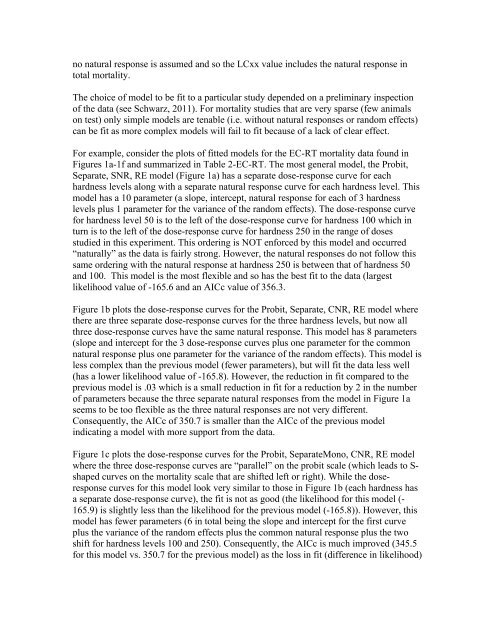Summary - People.stat.sfu.ca - Simon Fraser University
Summary - People.stat.sfu.ca - Simon Fraser University
Summary - People.stat.sfu.ca - Simon Fraser University
Create successful ePaper yourself
Turn your PDF publications into a flip-book with our unique Google optimized e-Paper software.
no natural response is assumed and so the LCxx value includes the natural response intotal mortality.The choice of model to be fit to a particular study depended on a preliminary inspectionof the data (see Schwarz, 2011). For mortality studies that are very sparse (few animalson test) only simple models are tenable (i.e. without natural responses or random effects)<strong>ca</strong>n be fit as more complex models will fail to fit be<strong>ca</strong>use of a lack of clear effect.For example, consider the plots of fitted models for the EC-RT mortality data found inFigures 1a-1f and summarized in Table 2-EC-RT. The most general model, the Probit,Separate, SNR, RE model (Figure 1a) has a separate dose-response curve for eachhardness levels along with a separate natural response curve for each hardness level. Thismodel has a 10 parameter (a slope, intercept, natural response for each of 3 hardnesslevels plus 1 parameter for the variance of the random effects). The dose-response curvefor hardness level 50 is to the left of the dose-response curve for hardness 100 which inturn is to the left of the dose-response curve for hardness 250 in the range of dosesstudied in this experiment. This ordering is NOT enforced by this model and occurred“naturally” as the data is fairly strong. However, the natural responses do not follow thissame ordering with the natural response at hardness 250 is between that of hardness 50and 100. This model is the most flexible and so has the best fit to the data (largestlikelihood value of -165.6 and an AICc value of 356.3.Figure 1b plots the dose-response curves for the Probit, Separate, CNR, RE model wherethere are three separate dose-response curves for the three hardness levels, but now allthree dose-response curves have the same natural response. This model has 8 parameters(slope and intercept for the 3 dose-response curves plus one parameter for the commonnatural response plus one parameter for the variance of the random effects). This model isless complex than the previous model (fewer parameters), but will fit the data less well(has a lower likelihood value of -165.8). However, the reduction in fit compared to theprevious model is .03 which is a small reduction in fit for a reduction by 2 in the numberof parameters be<strong>ca</strong>use the three separate natural responses from the model in Figure 1aseems to be too flexible as the three natural responses are not very different.Consequently, the AICc of 350.7 is smaller than the AICc of the previous modelindi<strong>ca</strong>ting a model with more support from the data.Figure 1c plots the dose-response curves for the Probit, SeparateMono, CNR, RE modelwhere the three dose-response curves are “parallel” on the probit s<strong>ca</strong>le (which leads to S-shaped curves on the mortality s<strong>ca</strong>le that are shifted left or right). While the doseresponsecurves for this model look very similar to those in Figure 1b (each hardness hasa separate dose-response curve), the fit is not as good (the likelihood for this model (-165.9) is slightly less than the likelihood for the previous model (-165.8)). However, thismodel has fewer parameters (6 in total being the slope and intercept for the first curveplus the variance of the random effects plus the common natural response plus the twoshift for hardness levels 100 and 250). Consequently, the AICc is much improved (345.5for this model vs. 350.7 for the previous model) as the loss in fit (difference in likelihood)
















